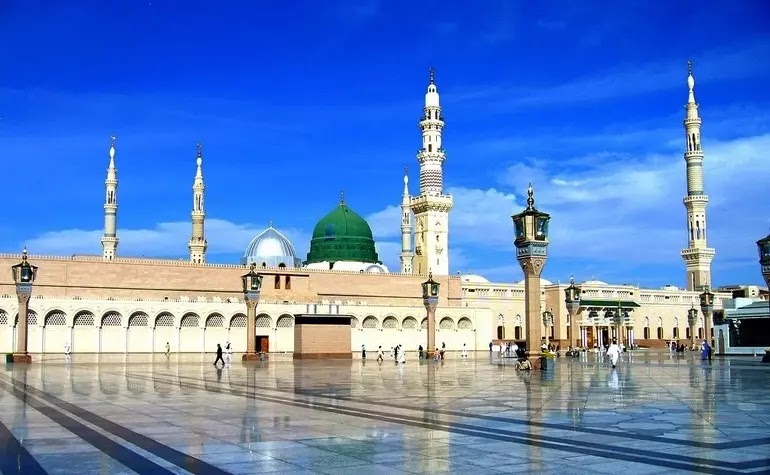History and Importance
Masjid an-Nabawi's set of experiences is interlaced with the existence of the Prophet Muhammad (harmony arrives) and the early Muslim people group. The mosque was initially a basic design worked on by the Prophet himself, soon after his appearance in Medina in 622 CE. Throughout the long term, it went through a few extensions and redesigns, mirroring the development of the Muslim Ummah and the rising significance of the mosque as the otherworldly and regulatory focal point of Medina.
Today, Masjid an-Nabawi holds colossal importance for Muslims. It is the second-holiest site in Islam after the Masjid al-Haram in Mecca. Muslims from wherever on the planet visit the mosque to offer petitions, search for favors, and express their appreciation to the Prophet. It is likewise the last resting spot of the Prophet Muhammad and his dearest friends, Abu Bakr, and Umar (may Allah be satisfied with them), making it a position of tremendous love and otherworldliness.
Architectural Marvel
One of the most striking parts of Masjid an-Nabawi is its dazzling engineering. The mosque is an amicable mix of custom and innovation, and its plan reflects Islamic style and standards. Its most particular component is the enormous, notable green arch that transcends the Prophet's burial chamber. This vault, which is apparent from different places in Medina, is an unquestionable image of the mosque.
The yard of Masjid an-Nabawi is tremendous and can oblige many admirers. It is perfectly embellished with meticulously planned minarets, calligraphy, and elaborate subtleties. The inside of the mosque flaunts impeccable light fixtures, unpredictably woven rugs, and an air of peacefulness that transports visitors to an alternate domain. The mix of current innovation and exemplary Islamic design has made the mosque a genuine work of art.
Unique Features
Roza (Riyadh al-Jannah): One of the most sought-after spaces inside Masjid an-Nabawi is Roza or the Nursery of Heaven. It is accepted that the region between the Prophet's lectern and his burial chamber is a piece of Jannah (heaven) on the planet. Muslims believe that any prayer made in this area is readily accepted by Allah.
Prophet's Minbar: The mosque contains the original minbar (pulpit) from which the Prophet Muhammad used to deliver his sermons. This historical artifact is a source of immense reverence for Muslims.
Baab as-Salaam: This door is also known as the Door of Peace. It is expressed that upon the arrival of judgment, the Prophet Muhammad will perceive and mediate with the individuals who entered the mosque through this entryway.
Prophet's Grave: The resting place of the Prophet Muhammad is
located within the mosque. It is a site of great emotional and spiritual
importance, and many visitors offer their salutations and prayers at this spot.
Date Palm Pillars: The mosque has a unique feature in the form of date palm tree pillars. These are reminiscent of the trees the Prophet used to lean on while delivering his sermons. Worshippers can often be seen embracing these pillars in devotion.
Spiritual Experience
Visiting Masjid an-Nabawi is a profoundly otherworldly encounter. The peacefulness of the mosque, joined with the feeling of history and commitment that penetrates its walls, significantly affects guests. Numerous Muslims feel a significant association with the Prophet Muhammad when they stand in the mosque's holy spaces. The call to supplication reverberating through the mosque is an indication of the immortal custom of love that has occurred here for quite a long time.
Besides, the feeling of solidarity and fellowship that one encounters while surrounded by individuals from varying backgrounds and different societies is really extraordinary. It fills in as a sign of the comprehensiveness of Islam and the lessons of the Prophet Muhammad, who was sent as a leniency to all of humanity.
Maintaining the Sacredness
With a great many guests consistently, Masjid an-Nabawi faces the test of saving its sacredness while obliging the requirements of a developing number of admirers. The Saudi specialists have gone to a few lengths to keep up with the profound climate of the mosque while guaranteeing the well-being and solace of guests. These actions follow severe guidelines for conduct, clothing standards, and admittance to a specific region of the mosque.
The preservation of the mosque's heritage and history is a continuous effort. Rebuilding and extension projects are attempted with absolute attention to detail to keep up with the engineering and verifiable meaning of Masjid an-Nabawi.
Masjid an-Nabawi is something other than a strict landmark; it is an honest, living demonstration of perseverance through force and solidarity. Its interesting mix of history, design, and otherworldliness makes it a momentous spot for Muslims and a wellspring of interest for individuals, everything being equal. The mosque has an attractive force, drawing a great many pioneers and sightseers to Medina consistently, each looking for a one-of-a-kind association with the tradition of the Prophet Muhammad. As the core of Medina, Masjid an-Nabawi keeps on sparkling as a brilliant image of harmony and dedication in the Islamic world.


.webp)


0 Comments